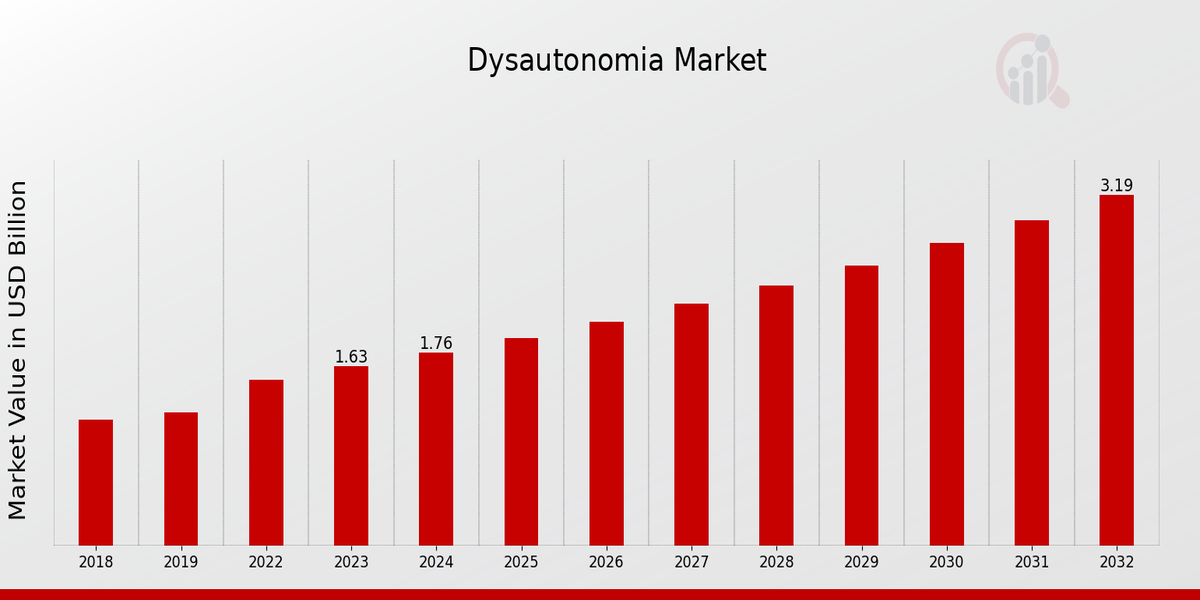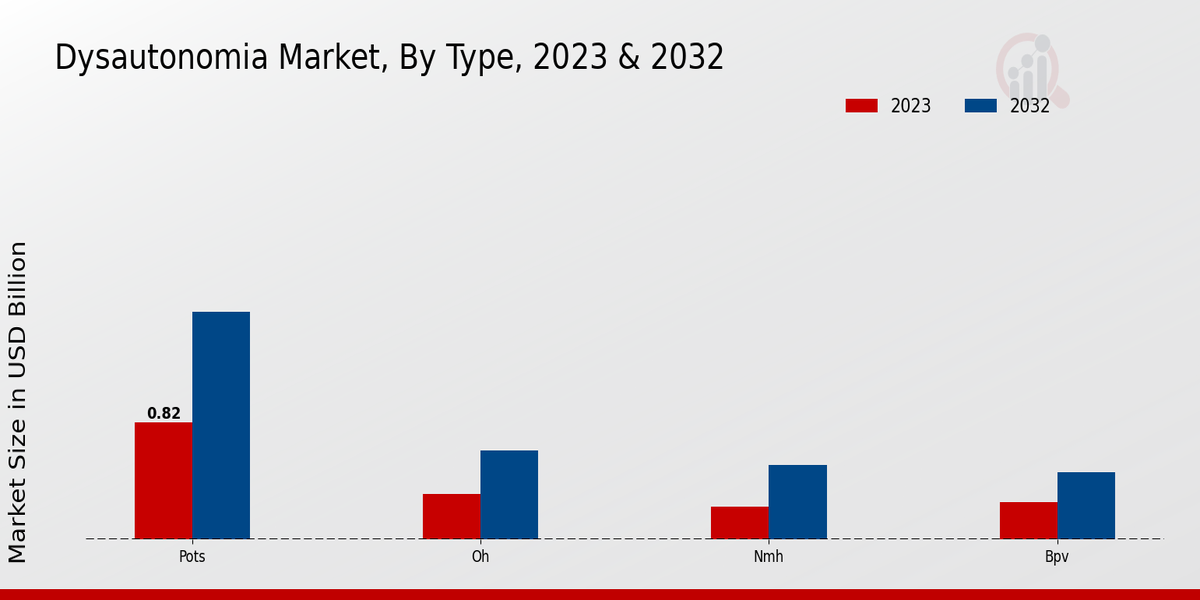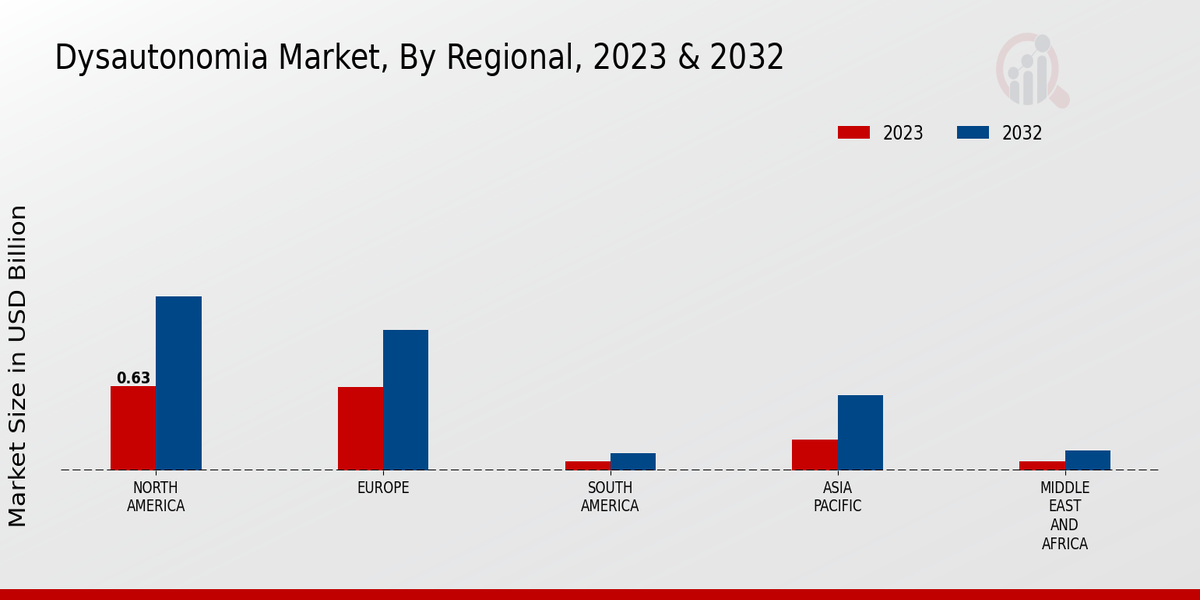Global Dysautonomia Market Overview
As per MRFR analysis, the Dysautonomia Market Size was estimated at 2.46 (USD Billion) in 2023. The Dysautonomia Market Industry is expected to grow from 2.77 (USD Billion) in 2024 to 6.72 (USD Billion) by 2032. The Market CAGR (growth rate) is expected to be around 10.34% during the forecast period (2024 - 2032).
Key Dysautonomia Market Trends Highlighted
In the dysautonomia market, recent advancements in diagnostic and treatment modalities, coupled with the growing understanding of autonomic nervous system disorders, are fueling market growth. Furthermore, the rise in research initiatives and government support for the development of innovative therapies presents significant opportunities for market expansion.
Key market drivers include the increasing prevalence of chronic diseases such as diabetes and heart disease, which can lead to dysautonomia, as well as the growing awareness and patient advocacy efforts.
Additionally, technological advancements in wearable devices and remote patient monitoring solutions are expected to shape the future of dysautonomia management, enhancing patient outcomes and driving market growth in the coming years.

Source: Primary Research, Secondary Research, MRFR Database and Analyst Review
Dysautonomia Market Drivers
Technological Advancements
Advancements in technology have played a vital role in driving the growth of the dysautonomia market. The development of cutting-edge medical devices and diagnostic tools has significantly improved patient outcomes and enabled more accurate diagnosis. These advancements have led to increased demand for specialized treatments, driving market growth. Additionally, technological advancements have facilitated the development of telemedicine platforms, allowing patients to access care remotely, further expanding the market's reach.
Rising Prevalence of Dysautonomia
The prevalence of dysautonomia has been on the rise in recent years, contributing to the growth of the dysautonomia market. Factors such as sedentary lifestyles, poor nutrition, and chronic stress have been linked to an increased risk of developing dysautonomia. The growing awareness of dysautonomia and its symptoms among healthcare professionals and the general population has also led to increased diagnosis rates, further fueling market demand.
Government Initiatives
Government initiatives aimed at supporting research and development in dysautonomia have played a significant role in driving the growth of the dysautonomia market. Funding from government agencies has enabled researchers to conduct clinical trials, develop new treatments, and improve patient care. Additionally, government initiatives have focused on raising awareness about dysautonomia, leading to increased demand for diagnosis and treatment, further contributing to market growth.
Dysautonomia Market Segment Insights
Dysautonomia Type Insights
The dysautonomia market is segmented by type into POTS, OH, NMH, BPV, and other dysautonomia. POTS (postural orthostatic tachycardia syndrome) is the most common type of dysautonomia, affecting approximately 1 in 100 people. POTS is characterized by an abnormal increase in heart rate upon standing, which can cause symptoms such as dizziness, lightheadedness, and fainting. OH (Orthostatic Hypotension) is another common type of dysautonomia, affecting approximately 1 in 50 people. OH is characterized by a sudden drop in blood pressure upon standing, which can cause symptoms such as dizziness, lightheadedness, and fainting.NMH (neurogenic mediated hypotension) is a type of dysautonomia that is caused by damage to the nerves that control blood pressure. NMH can cause symptoms such as dizziness, lightheadedness, and fainting.
BPV (benign paroxysmal positional vertigo) is a type of dysautonomia that is caused by a problem with the inner ear. BPV can cause symptoms such as dizziness, vertigo, and nausea. Other dysautonomia include a variety of other types of dysautonomia, such as multiple system atrophy, Parkinson's disease, and Alzheimer's disease. The growth of the market is attributed to the increasing prevalence of dysautonomia, the rising awareness of the condition, and the development of new treatments.
Source: Primary Research, Secondary Research, MRFR Database and Analyst Review
Dysautonomia Diagnosis Insights
The diagnosis segment of the dysautonomia market is set to rise sharply in the next few years. market growth is primarily driven by the increasing incidence and awareness of dysautonomia. Emerging technologies that enable more accurate and faster diagnostics also contribute to market growth on the diagnosis side. The tilt table test is one of the most routinely used tests to diagnose dysautonomia. The patient is placed supine and then the table is gradually tilted upright, once upright and the table is locked against movements, the blood pressure and pulse rate of the patients are closely monitored.
Another diagnostic test for autonomic functions is the Valsalva maneuver. The patient is asked to exhale forcibly while keeping the nose and mouth firmly closed. The changes in blood pressure and pulse rate provide information on the functions of autonomic systems.
Blood pressure monitoring can also be useful in the diagnosis of dysautonomia. It is done by taking the blood pressure reading in regular intervals. Autonomic reflex screen is another test used in the diagnosis of dysautonomia. It is a series of tests that measures the reaction of the patient to different simulated stimuli. Other tests may also be used to diagnose dysautonomia like nerve conduction studies and electromyography.
Dysautonomia Treatment Insights
Medications, lifestyle changes, therapies, and surgery are the four mainstays of treatment for dysautonomia. Medications can help to control symptoms such as orthostatic hypotension, tachycardia, and sweating. Lifestyle changes, such as increasing fluid intake, avoiding caffeine and alcohol, and wearing compression stockings, can also help to improve symptoms.
Therapies, such as physical therapy, occupational therapy, and cognitive behavioral therapy, can help to improve function and quality of life. The growth of the market is attributed to the increasing prevalence of dysautonomia, the rising awareness of the condition, and the development of new and innovative treatments.The dysautonomia market is segmented by treatment, which includes medications, lifestyle changes, therapies, and surgery.
The medications segment is expected to account for the largest share of the market in 2023, due to the widespread use of medications to treat dysautonomia. The lifestyle changes segment is expected to grow at the fastest rate during the forecast period, due to the increasing awareness of the benefits of lifestyle changes in managing dysautonomia.
Dysautonomia End User Insights
The dysautonomia market segmentation by end user includes hospitals, clinics, diagnostic centers, and research institutes. Hospitals account for a significant share of the market due to the high prevalence of dysautonomia patients and the availability of advanced diagnostic and treatment facilities. In 2023, the hospitals segment was valued at USD 1.13 billion and is projected to reach USD 1.67 billion by 2024, exhibiting a CAGR of 7.5%.
Clinics are another important end user segment, as they provide specialized care to patients with dysautonomia.The market size of the clinics segment was estimated at USD 320 million in 2023 and is anticipated to grow to USD 456.7 million by 2024, with a CAGR of 7.3%.
Diagnostic centers play a crucial role in diagnosing dysautonomia, and the market size of this segment was valued at USD 180 million in 2023. It is expected to reach USD 252.3 million by 2024, registering a CAGR of 7.4%. Research institutes contribute to the development of new treatments and technologies for dysautonomia, and the market size of this segment was estimated at USD 40 million in 2023.
It is projected to grow to USD 56 million by 2024, with a CAGR of 7.6%. The growth of the dysautonomia market is attributed to the rising incidence and prevalence of dysautonomia, increasing awareness about the condition, and the availability of advanced treatment options.
Dysautonomia Regional Insights
The dysautonomia market is segmented into North America, Europe, APAC, South America, and MEA. Among these regions, North America is expected to hold the largest market share in the coming years due to the increasing prevalence of dysautonomia and the presence of several healthcare providers. Europe is also expected to account for a significant share of the market due to the rising awareness of dysautonomia and the availability of advanced healthcare facilities.
The APAC region is expected to witness the fastest growth in the market due to the increasing healthcare expenditure and the growing population.South America and MEA are also expected to contribute to the growth of the market due to the increasing demand for healthcare services.
The dysautonomia market revenue is expected to reach USD 3.19 billion by 2032, growing at a CAGR of 7.74% during the forecast period.

Source: Primary Research, Secondary Research, MRFR Database and Analyst Review
Dysautonomia Market Key Players and Competitive Insights
The dynamics of the dysautonomia market involves significant investments in research and development, strategic partnerships, and acquisitions in the battle for a competitive advantage. Leading companies in the dysautonomia market invest in the development of new drug formulations and treatment methods and drug portfolios’ enhancement to cater for an increasing patient population. The market is characterized by the increasing number of cooperation agreements between pharmaceutical organizations and research firms to facilitate the efforts in the field of clinical trials and drug discovery.
Furthermore, technological advancements in the form of wearable and portable devices and applications are also among the key factors driving the development of the dysautonomia market through the means of more effective monitoring and self-management. Concerning the competitive landscape, the dysautonomia market is strongly fragmented, with both large, well-established companies and small, emerging firms contributing to the list of players competing for the market share.
Acorda Therapeutics Inc. is the leading market player in the dysautonomia market. It is an innovative pharmaceutical manufacturer with a focus on the market of neurological conditions in the form of Parkinson’s disease and multiple sclerosis. However, Acorda Therapeutics is distinguished in the market by a strong dysautonomia drug portfolio, including several LLC drug formulations currently under development for various types of dysautonomia.
Autonomic Technologies Inc. is a healthcare company specializing in the development and production of medical devices and products for the purposes of diagnosing and treatment. The organization offers the Q-Sweat System as a medical device used for the non-invasive evaluation of sudomotor function.
Lundbeck A/S, a major market competitor, is a leading player in the central nervous system therapeutics market. It is a Danish company developing various drugs to facilitate treatment for different neurological disorders. The company’s CNS drug list includes antidepressant, antipsychotic, anticonvulsant, and other types of drugs, supporting research in dysautonomia treatment with an emphasis on gene therapy and stem cell therapy.
Key Companies in the Dysautonomia Market Include
- Alnylam Pharmaceuticals
- Inova Pharmaceuticals
- Eisen Pharmaceuticals
- Autonomic Technologies
- Synapse Biomedical
- Theravance Biopharma
- QRxPharma
- Otsuka Pharmaceutical
- Zealand Pharma
- Lantheus Holdings
- Medtronic
- Nevro
- DyAnsys
- Retrophin
- NeuroMetrix
Dysautonomia Market Developments
The dysautonomia market is projected to grow from USD 1.63 billion in 2024 to USD 3.19 billion by 2032, at a CAGR of 7.74% during the forecast period. The increasing prevalence of dysautonomia, growing awareness about the condition, and advancements in medical devices and therapies are driving the market growth.
Recent news developments include the approval of new drugs for the treatment of dysautonomia, such as the FDA approval of midodrine in 2021 for the treatment of orthostatic hypotension.
Additionally, there is increasing investment in research and development of new therapies, such as gene therapy and stem cell therapy, which holds promise for improving the treatment outcomes for patients with dysautonomia.
Dysautonomia Market Segmentation
Dysautonomia Type Outlook
- POTS
- OH
- NMH
- BPV
- Other Dysautonomia
Dysautonomia Diagnosis Outlook
- Tilt Table Test
- Valsalva Maneuver
- Blood Pressure Monitoring
- Autonomic Reflex Screen
- Other Tests
Dysautonomia Treatment Outlook
- Medications
- Lifestyle Changes
- Therapies
- Surgery
Dysautonomia End User Outlook
- Hospitals
- Clinics
- Diagnostic Centers
- Research Institutes
Dysautonomia Regional Outlook
- North America
- Europe
- South America
- Asia Pacific
- Middle East and Africa
| Report Attribute/Metric |
Details |
| Market Size 2023 |
2.46 (USD Billion) |
| Market Size 2024 |
2.77 (USD Billion) |
| Market Size 2032 |
6.72 (USD Billion) |
| Compound Annual Growth Rate (CAGR) |
10.34% (2024-2032) |
| Report Coverage |
Revenue Forecast, Competitive Landscape, Growth Factors, and Trends |
| Base Year |
2023 |
| Market Forecast Period |
2024-2032 |
| Historical Data |
2019-2023 |
| Market Forecast Units |
USD Billion |
| Key Companies Profiled |
Alnylam Pharmaceuticals, Inova Pharmaceuticals, Eisen Pharmaceuticals, Autonomic Technologies, Synapse Biomedical, Theravance Biopharma, QRxPharma, Otsuka Pharmaceutical, Zealand Pharma, Lantheus Holdings, Medtronic, Nevro, DyAnsys, Retrophin, NeuroMetrix |
| Segments Covered |
Type, Diagnosis, Treatment, End User, Region |
| Key Market Opportunities |
New drug approvals Increased demand for early diagnosis Growing awareness Government initiatives Technological advancements |
| Key Market Dynamics |
Aging population Growing prevalence of chronic diseases Technological advancements Increasing healthcare expenditure Rising awareness of dysautonomia |
| Countries Covered |
North America, Europe, APAC, South America, MEA |
Frequently Asked Questions (FAQ) :
The dysautonomia market is was valued at USD 2.46 billion in 2023.
The dysautonomia market is projected to grow at a CAGR of 10.34% from 2024 to 2032.
North America held the largest share of the dysautonomia market in 2023.
The drugs segment is expected accounted for the largest share of the dysautonomia market in 2023.
Key competitors in the dysautonomia market include Acorda Therapeutics, Autonomic Technologies, Inc., and Cytonome/ST Inc.
Increasing prevalence of dysautonomia, growing awareness of the condition, and rising demand for effective treatments are some of the major factors driving the growth of the market.
Lack of awareness about dysautonomia, limited availability of effective treatments, and high cost of medications are some of the challenges faced by the market.
Rising demand for personalized medicine, increasing investment in research and development, and growing adoption of telemedicine are some of the opportunities for growth in the dysautonomia market.
Precision medicine, digital health, and patient-centric care are some of the key trends in the dysautonomia market.
The dysautonomia market is expected to reach USD 6.72 billion by 2032.

















